#south american wolverine
Text
The idea that prey nonhumans and predator nonhumans have beef with each other as if in nature predators and prey just hate each other and that's why carnivory exists: extremely anthropocentric mindset. I've literally been friends with people who were species that hawks or wolverines prey on in the wild and we never were even at odds over it. I'm a South American opossum who's friends with a crested eagle. It's mostly a lot of humans that cannot comprehend killing something you don't have spite for; after all, they get all their meat in packaged form from the grocery store and the only time they kill other animals is when they're mad at a spider for existing.
418 notes
·
View notes
Text
Round 1 - Side A
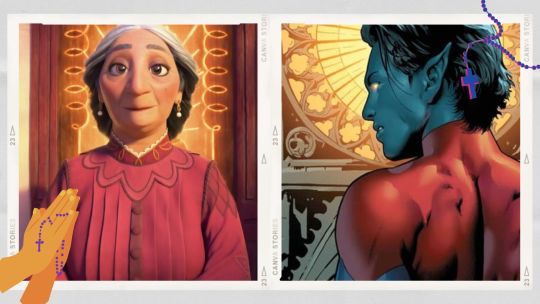
Propaganda below ⬇️
Abuelita Alma Madrigal Propaganda:
There's a church in the Encanto as well as a priest and given how strong her grip is and how much of a control freak she is, I would very much doubt she'd allow people to believe in other miracles than Pedro's if she wasn't, herself catholic. Also I mean south american turn of the century family they're probably catholic.
Listen at least Alma is!!! The candle!! The importance of the church!!! The vibes are just there!!!! The idea of being a savior by sacrificing yourself (or at least your personality/grief) for your people? That’s SO catholic coded PLEASE
Kurt Wagner/Nightcrawler Propaganda:
good lord where do i start. in the animated series he converts logan to catholisism and then fucks off basically thats the main thing he did there. i think one time they tried to make him a demon to explain how he looked but everyone hated that. he sold his soul one time to help his friends out after he died. he and logan have a weird little gay thing. he was a priest one time but he was made a priest by a fake bishop from a religion that hates mutants iirc so he just wasnt a priest. like 3 people have written him in a way i like and one of those is my friend just talking about how they view him.
wow marvel loves making catholic characters dress/look like demons
Kurt is a mutant who was born to mystique who looks a LOT like a devil (technically is half one but that cannon truth isn't real go back to bed), his mother dropped him off a cliff when he was born and he was picked up by a Romani group/circus (fuck old comics man) however he then narrowly escaped being sold to a freak show and found himself in a small German town. There he met a kind priest, who showed him God, and he quickly grew attached to the idea- However, it wasn't long before people began labeling him a demon and soon the whole town was against him with pitchforks and fire. Cornered and injured, Kurt thought this might be the end for him- maybe he would see heaven so long after finding it- but he was then saved by Charles Xavier who invited him to the X-Men. AND ITS BEEN SO MANY YEARS AND HE HAS BEEN THROUGH SO MUCH THERE. SO MUCH. SO GOD DAMN MUCH. BUT THE MOST AAAA THING TO ME CONCERNING HIS FAITH HE WHEN HE LITERALLY DIED AND WENT TO HEAVEN BUT THEN BECAUSE OF DRAMA WITH HIS FATHER HAD TO BRING HIS FRIENDS IN WITH HIM FROM THE BEYOND. THEN WITH ALOT OF TROUBLE THEY FOUGHT HIS FATHER AND THE ONLY WAY KURT SAW TO STOP HIM WAS IN A MOVE THAT STRIPPED THEM BOTH OF THEIR SOULS AND PUT THEM BACK ON EARTH. SO KURT CANONICALLY HAS NOW LOST HIS ABILITY FOR ETERNAL PEACE, LOST HIS VERY SOUL, TO SAVE PEOPLE- AND ALSO TOLD NO ONE NOT EVEN HIS GAY LOVER WOLVERINE.
Nightcrawler is a mutant vigilante who looks like a classical demon. He can't even go to church without people panicking and trying to exorcize him. Despite it all, he's so full of faith and hope and compassion, and he wants to believe the best of everyone. Also, he's bffs with an extremely angry Jewish sword lesbian. That has nothing to do with anything, but it's important to me that you all know that.
What if you were a devout christian and literally looked like the devil? He nearly became the pope, which was a plot by some supervillains that also involved faking a rapture? There is nothing like comics I swear to god.
A catholic who is half demon I don’t think I can better explain a struggle than that. But his character is so relatable to people who feel unwelcome with their congregation because of something that is a part of them but still feeling a connection to the faith. Kurt actively engaged in his faith and shares how his faith helps him through all the things he has faced in life and how he found a home with those of the church who leave the judging to God.
so they made kurt a priest briefly before deciding to retcon it, resulting in nightcrawler actually being part of a plan by villains to promote him to pope then reveal to the world that the pope is a demon. wild.
I have a side blog and a tattoo about him and i really really want him to win
Wisecracking devil-appearing devout Catholic with the Best superpower (teleportation)? HECK YES
German Catholic circus acrobat who looks like a demon & can teleport through a hellish alternate dimension with a puff of sulfur. Character of all time.
hes catholic and his dad is the devil. what could be funnier than that. also hes my silly little guy.
Nightcrawler is the world’s most fun catholic priest. I first was introduced to this kindhearted teleporting acrobat while he saved a boat full of stowaway refugees from inter dimensional pirates with swashbuckling gusto!
#encanto#alma madrigal#abuela madrigal#x men#kurt wagner#nightcrawler#marvel#cct polls#tumblr tournament#tumblr polls#tumblr bracket
202 notes
·
View notes
Text
A thing that I love to do is to intentionally unlearn English common names for plants and animals. Ascribing of strict formal names to living things for processing through institutionalized knowledge systems is an act of capture. And I am not interested in capturing, possessing, any creature.
What do some English common names teach us about a creature? Names are powerful. These are things that I often contemplate together in relation to each other: “folk” taxonomy, animal naming conventions, erasure of local environmental knowledge, the theft and extraction of Indigenous language and knowledge, and rare and endemic species with specific microhabitat preferences.
---
You might come to find that a creature, like a frog in the tropical Andes, is named for a museum curator in London who had never visited the Andes, or the frog is named after an eighteenth century plantation owner who contracted the European land surveyors to map the area.
There are so many creatures named after racists, eugenicists, violent colonizers. Of course, Linnaean taxonomic naming conventions were being established alongside the height of European maritime dominance, plantation slavery, and colonization of the American hemisphere, Australia, South Asia, the tropics.
A frog might be named after an imperial British adventurer who recorded the creature for audiences at European museums. They called “dibs” on the frog, despite the fact that local Indigenous communities may have had an ongoing relationship with the creature for centuries. So instead I’m interested in trying to learn a “folk” name for the creature, or instead I would apply a new name for an animal based on the geographic area, ecoregion, plant community, or ecocultural region that the creature was most closely associated with.
---
Here’s a situation:
There is a relatively little-known salamander species. It is superlative. The terrestrial adults are enormous, and can be purple-ish in color, marked with gold speckles that seem to glow like glitter. They’re one of the only salamanders on the planet that can vocalize. They live in habitat alongside grizzly bears, mountain lion, wolverine, moose, unique lichen-eating mountain caribou, land snails, big ferns. The aquatic larvae can reach lengths of over 30 centimeters (1 foot), and they live not in still water like ponds and lakes as most other salamander larvae, but instead they swim around in fast-flowing streams.
It’s an endemic species. It lives in just a few small rivers’ watersheds, mostly in small, fast-flowing, cold, clear mountain streams in temperate rainforest ecosystems in the Columbia Mountains of the Northern Rockies, almost entirely within the arbitrary political borders of the US state of “Idaho,” on the traditional land of Nimiipuu (Nez Perce) people and Schitsu’umsh (Skitswish/Coeur d’Alene) people.
And it’s official common name: “Idaho giant salamander.” Not cool. Does the salamander have a meaningful reciprocal relationship with a political entity less than 200 years old, or does the salamander have a relationship with the ancient cedars of the rainforest? Which has existed longer: the arbitrary political entity of Idaho, or the Nimiipuu people? What do some English common names teach us about a creature? Names are powerful. Is the salamander named after the streams, the source of its life? Is it named after the temperate rainforest ecoregion, this safe harbor of fertile vegetation? Does its name refer to the endemic tailed frogs or other aquatic creatures that it relies on for food? Does the name reference the Nimiipuu, who have known the amphibian for centuries? Even the region’s name (”Columbia Mountains”) is a reference to one of history’s most notorious celebrities.
---
Here’s something from Robin Wall Kimmerer:
In the English language, if we want to speak of that sugar maple or that salamander, the only grammar that we have to do so is to call those beings an “it.” [...] In Potawatomi, the cases that we have are animate and inanimate, and it is impossible in our language to speak of other living beings as “it”s. [...] [W]hen we name something, often with a scientific name, this name becomes almost an end to inquiry. We sort of say, well, we know it now. We’re able to systematize it […]. It’s such a mechanical, wooden representation of what a plant really is. And we reduce them tremendously if we just think about them [solely] as physical elements of the ecosystem. […] This comes back to what I think of as the innocent or childlike way of knowing. Actually, that’s a terrible thing to call it. We say it’s an innocent way of knowing, and, in fact, it’s a very worldly and wise way of knowing. That kind of deep attention that we pay as children is something that I cherish, that I think we all can cherish and reclaim, because attention is that doorway to gratitude, the doorway to wonder, the doorway to reciprocity.
Words of Robin Wall Kimmerer. Interviewed by Krista Tippett. “On Being with Krista Tippett - Robin Wall Kimmerer: The Intelligence in All Kinds of Life.” February 2016.
---
It’s also important to me to clarify that, when referencing an Indigenous name or term for landmarks, places, plants, animals, etc. I only really feel comfortable doing so if the name is explicitly used by and/or confirmed to be accurate by speakers, researchers, knowledge-holders, etc. from that Indigenous community. And I also don’t want to use/share a name/term if the name/term was “collected” (appropriated, extracted) by a chauvinistic white academic or paternalistic Euro-American “ethnologist” or reproduced in a 1950s ethnobotany book or something. I especially don’t like relying on the testimony of, like, Euro-American missionaries or “traders’ who recorded terms in their personal journal in the 1750s or something.
How were those terms encountered?
How were they “extracted”?
Under duress?
Were these names, this environmental knowledge, willingly shared?
What ethical implications are there, of accepting secondhand information from an invading “pioneer”?
Many times, I’ll be reading a paper, maybe a “contempoary” paper from the past 10 years, and see references to a cool-sounding place-name or alternative name for a creature, and I’ve thought “wow, the connotations of the name sound really interesting, I wonder where this was learned,” and I’ll check the bibliography, and the “Indigenous name” was taken from a 1965 academic article, which itself was taken from a 1922 ethnology article sponsored by the F0rd Motor Company in pursuit of stealing local plant knowledge and land titles for rubber plantations or something, and that info itself was taken from an 1874 report from settler-colonial surveyors interviewing “locals” while traveling in company with an ex-government employee “cowboy” who had previously murdered at least 5 of the “locals.” So that, often in Euro-American “Knowledge” or “Science”, when trying to determine the Source Of A Fact, there is this blatant lineage of theft and violence and roundabout superficial self-referencing.
Even in relatively modern academic journals. Let’s say, in the 1990s, a European academic does “field research” in Amazonia. Maybe they record an “accurate” term, and I read about it in a paper. The academic says that they have a “profound respect” for “the culture”. Does this make it OK to “take” their terms? Does this make it more acceptable to “extract” a language as if it were a resource, a possession? Does it change the fact that the sponsoring academic institution or the publishing journal are both entangled with corporate extraction and ongoing (neo)colonial financialization, dispossession, debt, etc.?
So (1) you’re presented with names/terms which are probably inaccurate and which you have no way of confirming because of the convoluted way the term was passed down through settler-colonial knowledge-systematization institutions; and/or (2) more importantly, you’re presented with names/terms stolen, often at threat of violence; or (3) even in “good” scenarios with an accurate term and a so-called self-professed “respectful observer”, you’re presented with names/terms which have great power, connected to a specific culture and landscape, which should be treated with reverence and deep care, but which can easily be stolen and appropriated by popular media, wielding the power of the name in contexts where it doesn’t belong, a betrayal to the people, place, and/or creature.
---
Names imply or explicitly reveal the life of a creature or place, and also imply the connections between the creature/place being named, and the other worlds and relationships it influences and interacts with.
If i am not from the community that conceived the term/language, (1) it doesn’t feel honorable appropriating their language for myself, especially if I don’t have ongoing personal connection to people, places; (2) it doesn’t feel honorable, or all that reliable, to accept at face value the accuracy of a language/term if it’s being reported secondhand by a Euro-American academic intermediary, especially if that language was recorded during periods when Euro-American observers were actively engaged in colonization; and (3) it doesn’t feel honorable to use what might even be accurate Indigenous language/terminology if it was recorded/learned/stolen/promoted by Euro-American observers, unless there is explicit permission from native speakers to use the word, or unless native speakers actively encourage the acknowledgement of the words, maybe for purposes like language revitalization.
There is power and knowledge in a name. using a name involves serious responsibility. i feel that some names aren’t for me to invoke.
---
I think that maybe no name can do justice to the entire rich existence of a creature, but we can really do better than some English common names, especially in those cases when an animal is named after a lone individual human. And so, in naming, there might be a difficult decision to make. Do you name a creature for its behavior, its location, its appearance, its season of activity, its prefered habitat, its companion species? Maybe you have your own, personal, relationship with the creature. A living thing has so many interweaved relationships with others. Maybe its “meaning” changes with context or season or emotional state of the human observer. Maybe I will sometimes call the “Idaho giant salamander” something more fitting. Maybe I’ll call it “the cedar salamander” or the “guardian of the waterfall pools” or “the giant of the stream” or “moss dragon” or whatever. Depends on the mood, context, whatever.
We are all of us, salamander and human, more rich and complex than associations with mere behavior, appearance, habitat preference, or the surveyors that try to capture and catalogue us. And sometimes, I’m uncomfortable enclosing us with a singular denomination, with a strict name. I don’t assume that I know enough about a living thing to possess it through formal naming conventions.
#this is all just copy pasted and slightly edited from older posts of mine on this site#but the naming conventions of the frogs in Ecaudorian tropical Andes had me thinking about this#abolition#interspecies#ecology
224 notes
·
View notes
Note
what is wyrmclan's relationship with wolverines? those lil guys are ferocious and also quite rare, i believe? and they only really live in remote forests, taigas and tundras of high latitudes, so would that make make Wyrmclan a tunnel-dwelling clan in the high latitudes of Europe/Asia/North America?
(for context, i always imagined Wyrmclan as a south american clan for some reason????????????/ idk why also 🐈 cuz im curious for more facts)
I was thinking that WyrmClan would imagine that wolverines would kind of embody the angry spirits of any cat unfortunate enough to die in a tunnel collapse. There are a couple of confirmed burrows on the territory that Riftstar has instructed his cats to leave in peace. There might be warning signs left in the areas near the dens, like a specifically colored stone or type of flower.
That's one of the first lesson any WyrmClan apprentice learns: How to know when to run away from danger.
38 notes
·
View notes
Text
The Logistics of Predation and Creationism
Creationism is a bur, with a lot of arguments against it, but one I favor doesn't come up much. The Logistics of Predation.
What I mean is, predators are naturally competitive with each other, as are any animals that share food sources. So, the role of 'top predator' can be in dispute.
Creationism's "All Prehistoric Animals lived at the same time" approach to biology underlines their failure to understand just how diverse and varied prehistoric animals truly were.
Illustrating that by just listing the large mainland land predators of North America down to the subfamily/family is... something that amuses me, because it just keeps getting bigger than you expect it!
Allow me:
First, we need to start with the current predators of North America:
There are Wolves and Coyotes (Genus Canis); Black, Brown, and Polar bears (Ursus), Mountain Lions (Puma), the occasional Jaguar (Panthera), the American Alligator (Alligator), and American Crocodile (Crocodylus). The smaller of these animals is 53kg on average, so we'll use that as our 'cutoff' point.
Now, Creationists have this concept called "Kinds" which they equate to the Linean concept of Family. This doesn't mean much here, as each Genus listed here is also the sole genus over 53kg in North America for that family.
Following the Geologic Column, the first step down adds the following apex predators:
Within the existing families, we get Cats (Saber-Toothed Cats, the American Cheetah, the American Lion), Dogs (Dire Wolves), and Bears (Short Faced Bears), so I won't "Count" them for this list, but they are worth a mention at least. The first new "Kind" is...
Cave Hyenas - Yeah, Hyenas made it to the Americas, but only via the polls. The animal was a subspecies of the spotted hyena, known as Crocuta crocuta spelaea. The species was found in Alaska and Northern Canada, but no further south than that.
Inside the existing families, we have: the Bone Crushing Dogs/Wargs of the Borophaginae sub-family; and the Dog-Bears of the Hemicyonidae subfamily of Bears.
The Terror Birds - Mostly known in South America from the genus Titanis, standing 2-2.5 meters (6 and 1/2 to 8ft) tall and 200kgs (440lbs) in weight, is found from Texas to Florida, and into Central America from there. It was a beast to be reckoned with that can and would peck you to death with its pickax beak and gut you with a kick -- and yes, it had a raptorial claw like a Dromaeosaur of old to make their kick that much deadlier. It could run as fast as an ostrich and its beak could crack bones.
The next "Kind" we get appears in what is known as the Cat Gap, where there were no cats in the geologic column. Instead, we had other things:
For new families, there are:
Megalictis - A ferret as heavy as a jaguar. This is the first truly large mustelid that we have in North America. Proportionally, it's like an upscaled Wolverine (this thing was almost than twice as heavy as even the heaviest Wolverine).
Amphicyonidae - The Bear-Dogs, not to be confused with the Dog-Bears. They had the long snout and tail of a dog but with heavy bodies and flat feet of a bear. There are three sub-families within North America and a LOT of species for each genus in the fossil record.
Entelodontidae - Pig-Like Omnivorous giants with the attitude of hippos. Oh, and the biggest, Daedon, was as tall as a man at the shoulder with a 3ft long skull with a bone-crushing bite. Sometimes they are called the "Terminator Pig." Though technically, they were more closely related to hippos than true pigs. So, an omnivorous land-hippo that's 6ft tall at the shoulder. Let that simmer for a bit.
Hyaenodontidae - Creodont predators unrelated to hyenas, built with heavy heads full of massive blade-like teeth. Pretty dumb all things considered, but brute force incarnate.
Barbourofelis - Despite appearances, they are not Saber-Toothed Cats. They are feliforms, but they are not felines and not part of the same line as Smilodon and its relatives. They were bulkier, dumber, and had different ear designs. But straight up? It's hard to tell them apart as a layman but is notable for having 'sheaths' for their saber teeth.
Nimravidae - Another group of "False" Saber-Toothed Cats. Shorter legs, a different inner-ear configuration is another case where it's hard to tell just from the skeleton that it's not quite a cat by a layman. The ones to count as 'top' predators in North America is limited to Hoplophoneus, Pogonodon, and Dinictis (which is just within if we round up).
Oxyaenidae - A smaller group of Creodonts, but still producing a few large predators such as the Patriofelis (90kg) and Palaeonictis (30kg). They were sort-of cat-like in appearnace (particularly Patriofelis) but were nowhere near as intelligent and more head-heavy.
Mesonychidae - Hooved Wolf/bear-like predators. The largest of these, Ankalagon, was the size of a grizzly. Other Genus include Pachyena, Mesonyx, and Harpagolestes.
Borealosuchus - A Not-Crocodile Crocodilian. Despite claims of being 'living fossils', crocodilians were an extremely diverse clade in the past. This is a link of sorts between that odd past and their present. The largest species of this could get as big as a Saltwater Crocodile.
Boverisuchus - A land-living/hunting crocodilian. It would have looked like a crocodile but with longer, straighter legs. These animals galloped like horses, even having hooves on in place of claws on their limbs. This animal could stand up on its hind legs as well. It would have been more active and dangerous than a similarly sized alligator. With slashing teeth, its bite would wound prey heavily with one bite. Its tail was also rounded and heavily armored, making it a potent defensive weapon.
From here on out, we get to the Dinosaurs.
Troodontidae - The "Brainy" dinosaurs, despite mostly being small, could get quite large. Some teeth and other remains indicate specimens between 64 and 195kg. The largest of these, the Alaskan Troodon, may be a case of polar gigantism and Island gigantism.
Tyrannosauridae - This large family of very large carnivorous dinosaurs has been split into several sub-families. North American ones include Albertosaurinae (Albertosaurus, Gorgosaurus), Daspletosaurini (Thanatotheristies, Daspletosaurus), and Tyrannosaurini (Tyrannosaurus). Outside those three are Nanuqsaurus, Teratophoneus, and Lythronax.
Tyrannosauroidea - A bit more primitive than Tyrannosuaridae, many being the ancestors of the big famous ones above. These include Dryptosaurus from New Jersey, Appalachisaurus from Alabama, and the smaller Stokesosaurus from the Jurassic period of Utah.
Carcharodontosauridae - A family of large carnivorous dinosaurs designed for ripping flesh from large targets. As big as the biggest Tyrannosaurs. This includes animals like Siats and Arcocanthosaurus.
Eudromaeosauridae - "Raptors". These ranged from coyote-sized to bear-sized. In North America, this included mostly the Dromaeosaurinae. Featuring: Yurgovuchia, Deinonychus, Utahraptor, and Dakotaraptor (unless that's an Unenlagia relative).
Azhdarchidae - A terror of the skies, Quetzalcoatlus and its relatives form a family of gigantic, giraffe-sized pterosaurs which behaved like storks. This means that they would be gobbling down things as big as people. It's 30ft+ wingspan would darken the skies and terrorize the land.
Deinosuchus - This early Alligatorid (not a true member of the family) grew to the size of Tyrannosaurs and lived mostly in saltwater/brackish conditions.
Allosauridae - The Allosaurs and its relatives. Large open-living predators of sauropods. This includes the famous Allosaurus and the gigantic Saurophaganax. It seemed to have favored the planes compared to other therapods found nearby.
Megalosauridae - Including the giant Torvosaurus. Another large carnivorous dinosaur. One of the first to be over 3 tons. More of a forest dweller, it was among the last of its kind.
Ceratosaurus - Another predatory dinosaur with a large horn on its nose. Seems to have favored wetter, forested environments.
Dilophosaurus - Notable for its distinct crest and was actually powerfully built and strong, rather than the small spitter-of-venom seen in the movies. Its crests were even more pronounced and bizarre, too.
Coelophysoidea - Slender, usually coyote-sized dinosaurs, some of them, like the wonderfully named Gojirasaurus could get quite large, over 100kgs. And, c'mon, it's Gojirasaurus! Named in honor of Godzilla! We have to include it.
And that's it for dinosaurs.
Postosuchus - An early attempt to make something like a carnivorous dinosaur, but from a more crocodilian base. Heavy head, powerful hind legs, but not quite the same thing. Scalier, bulkier, dumber, less agile. Still, something to be feared.
Ctenosauriscidae - Another "Croc Trying the Dinosaur Thing" Family that didn't survive the Triassic. These animals had large sails on their backs like Dimetrodon. Arizonasaurus is the only genus known from North America.
Poposauridae - Really good "Dinosaur" mimicking Crocodilian-line archosaurs. Some were mistaken as dinosaurs at first, but we figured the differences out with more fossils. The best-studied of these is Poposaurus, which looked like a stereotypical carnivorous dinosaur, but with more fingers, more scales, and different ankles/hips.
Phytosauridae - Fake Crocodiles. They are archosaurs, but not Crocodiles in any other sense other than the niche they fill. The key difference is the placement of the nostrils. Some of these could get HUGE too. Brachysuchus, Centemodon, Leptosuchus, Machaeroprosopus, Pravusuchus, Protome, Redondasaurus, Rutiodon, Smilosuchus, Smilosuchus, Wannia, and Angistorhinus are known genera.
Temnospondyli - A large group of amphibians, technically a sub-class, but to the layman, these are all "Crocomanders" - amphibians filling in the crocodile-niche. On average, they were crocodile-sized and shaped. Only a few bucked that trend, such as Eryops, whose squat body made it very frog-like in appearance. These included multiple families of large predatory amphibians: Tupilakosauridae, Eryopidae, Metoposauridae, and Brachyopidae. Tupilakosaurs were like big mudpuppies or modern giant salamanders. Eryipids were more rounded, like frogs with tails, only as long as a man. Their jaws were more alligator-like, but with extra teeth in the roof of their mouth for added damage. Metoposaurs were among the most commonly found in certain environments, with flat, rounded, triangular heads and salamander-y bodies. Brachyoopids had shorter, boxier heads and were flatter overall.
From here we leave the Mesozoic and go to the Permian. Records of North America in this section of the column are... incomplete. The last era of it is utterly missing for land vertebrates. So, we don't have records of fun things like Gorgonopsids.
We have:
Steppesaurus - This animal is controversial. It may be a Sphenacodontid, but it has also been classified as Phthinosuchid, but that is controversial given how old it is. We may never know what it was, but it was BIG for its time.
Varanopidae - Named after Monitor lizards, they are closer to mammals than to their namesake. The largest of these could be the size of a Komodo Dragon, but more active.
Sphenacodontidae - Here we get something people will recognize again: Dimetrodon, but it also includes predators like Ctenorhachis, Sphenacodon, Secodontosaurus, and Ctenospondylus. Some had sails on their back like dimetrodon, some had a half sail, and some had no sail at all. They all had early differentiated teeth. Dimetrodon is of particular note given how many species there were (19 of them lived in North America), ranging in size from that of a lion to that of a house cat (D. natalis).
After that, there are smaller predators of note (such as seagull-sized dragonflies) but none meet our definitions for apex predator in terms of mass and habitat.
So, with bringing it down to the Family level, that still leaves 39 Large Carnivores running around at the same time. Even on the same continent, this is an absurd number of carnivorous animals! Imagine trying to get a drink with all that to be alert for!
And that is just one of the many reasons why creationism is absurd.
25 notes
·
View notes
Text
listen. I'm from South Asia. I just thought they made something up with 'wolve-" in it.
Also tell me if you're USAmerican/North American in general if you're comfy with that
8 notes
·
View notes
Text
After reading actually god knows how many issues (we must be well above 100) Krakoa and its political landscape is finally starting to grow on me. (no pun intended) Funny little war crimes superhero nation on a sentient island. One of the laws is "fuck nasty." Everyone's politics suck. Beast colonised a south american country using sentient plants. The Summers family + Wolverine (poly rights) lives on the moon. They have their own Met gala. Mars got terraformed during the mutant met gala and got declared the capital of the solar system. Nova nearly threw a fit over it. There's corrupt druids and wizards inolved in uk politics. Cancer has been cured by flower petal miracle medicine. Charles Xavier is still somehow a bastard
8 notes
·
View notes
Text
So here's some really fun trivia for y’all!
For my "Idea of the American South" graduate school class, we just had to read William Faulkner's novel Absalom, Absalom! this week, since Faulkner is highly regarded by historians for his nuanced portrayal about the darker side & systemic injustices of the Deep South. But this was actually not my first exposure to Faulkner, since one of his other novels, Go Down, Moses, was actually directly referenced in The Adamantium Men arc of Jason Aaron's Wolverine run. In the arc, the evil Roxxon corporation managed to duplicate the Weapon X procedure which gave Logan his adamantium claws to a bunch of private mercenary henchman in order to act as bodyguards for the company's illegal activities overseas. And they all have lightsaber claws!
One of the titular Adamantium Men was apparently a huge Faulkner fan and was even reading a first edition copy of Go Down, Moses before being told by a Roxxon higher-up to assassinate Wolverine. But when said-mercenary realizes that he's about to lose the fight, he actually asks Logan to spoil the ending of the novel for him before he dies, and Logan honors his request!

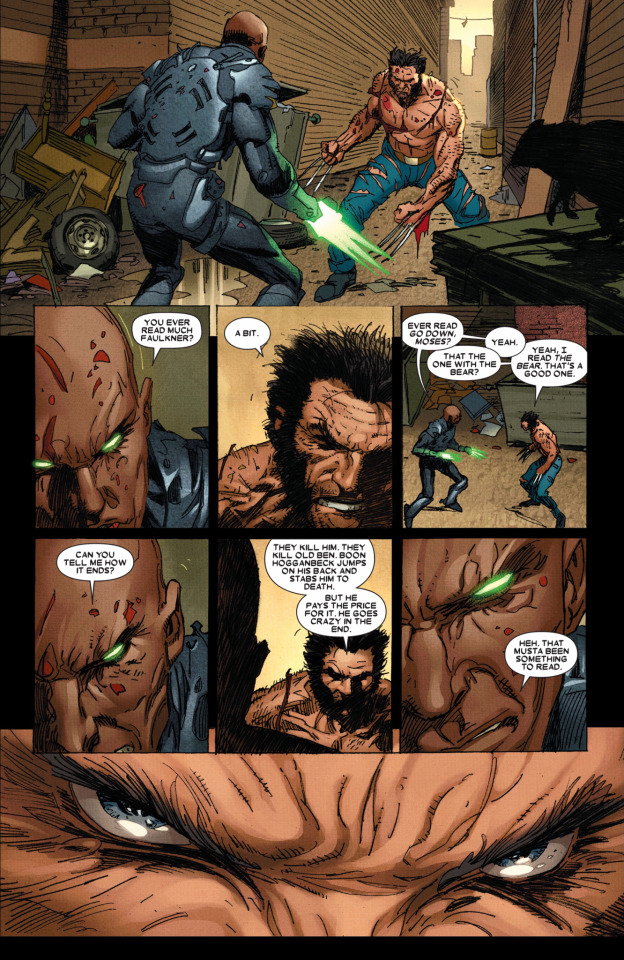
I was told that the copy of Go Down, Moses displayed in the comic is actually the original first-edition copy from the guest-lecturer for said-class since it was the only version to ever feature the subtitle “And Other Stories” on the front cover.
And it honestly makes sense that Aaron would reference Faulkner's work since he's similarly written stories which are highly critical of the American South such as his Image Comic series Southern Bastards. One issue of that series even had a variant cover featuring glorious sight of a dog ripping a Confederate flag to shreds!

So beautiful! I would love to train my dog Zoe to do the same thing to one of those AWFUL flags! Plus, the royalties for that variant cover were even donated to the survivors & families of the Charleston mass-shooting in 2015.
From Wolverine: Weapon X #4 by Jason Aaron & Ron Garney.
#wolverine#james logan howlett#adamantium men#roxxon#william faulkner#Absalom Absalom!#Go Down Moses#jason aaron#ron garney#marvel comics#southern bastards#image comics#screw the confederacy#the confederate flag is a hate symbol#i love dogs#historical trivia
9 notes
·
View notes
Text
Deadpool 3 star Karan Soni teases several cameos in Deadpool & Wolverine: “This new MCU version is ultra-secretive”
Deadpool 3 will be released on July 26, 2024, in English, Hindi, Tamil and Telugu.
The anticipation surrounding Deadpool 3 has reached a fever pitch. The film marks the return of Ryan Reynolds as the irreverent and indestructible Wade Wilson, a.k.a. Deadpool. The icing on the cake? Hugh Jackman is hanging up his retirement hat to once again don the claws of Wolverine, marking his return to the X-Men universe. During Superbowl 2024 weekend, Marvel Studios unveiled the first teaser of Deadpool 3, Deadpool & Wolverine, creating excitement amongst the fans. The film also marks the return of Indian-American actor Karan Soni as Dopinder. In a recent conversation, the actor teased about the third installment, Jackman’s involvement and more cameos.
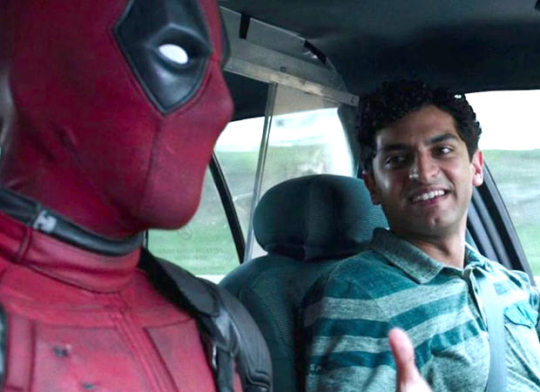
Speaking to Variety during the South Asians at the Oscar party event, Karan Soni talked about Hugh Jackman’s return and said, “When we were making the second one, Ryan was plotting back then. I remember him spilling that at lunch one day that he had started a conversation with Hugh. I remember saying, ‘People are going to flip out!’ Then the studio got sold to Disney and a lot of other stuff happened. But, of course, Ryan followed through because it was dream casting.”
He also teased that fans can expect several cameos. “This new MCU version is ultra-secretive,” he said, adding, “There are a lot of surprises. Let’s just say a lot of people traveled to London.”
Deadpool 3 promises to be a thrilling addition to the Deadpool franchise and the Marvel Cinematic Universe at large. The upcoming film stars Ryan Reynolds, with Wolverine star Hugh Jackman reprising his role. Brianna Hildebrand and Shioli Kutsuna are returning in addition to Karan Soni, Leslie Uggams, Morena Baccarin, Stefan Kapicic and Rob Delaney.
Jennifer Garner is also reprising her role of Elektra after 20 years. She first played the role in 20th Century Fox’s 2003 feature film Daredevil which starred Ben Affleck. However, she was also headlining the spin-off.
Deadpool 3 is being produced by Marvel’s Kevin Feige, director Shawn Levy and Ryan Reynolds. The script is by Reynolds, Levy, Paul Wernick, Rhett Reese, and Zeb Wells. Deadpool 3 will be released on July 26, 2024, in English, Hindi, Tamil and Telugu.
#Deadpool & Wolverine#Deadpool 3#Emma Corrin#Hollywood#Hugh Jackman#International#Jennifer Garner#Karan Soni#Leslie Uggams#Marvel Cinematic Universe#Marvel Cinematic Universe (MCU)#Matthew Macfadyen#Morena Baccarin#Rob Delaney#Ryan Reynolds#bollywood hungama
2 notes
·
View notes
Note
whats your favorite animal?
It'd be easier to relegate it to continent. In Australia it's crocodiles. Africa would be elephants. North America is... I don't know, wolves I suppose? Maybe elk (what North Americans would call moose). Europe would be wolverines. South America is the maned wolf. Asia is the Przewalski's horse. Antarctica would be orcas.
4 notes
·
View notes
Text
9-1-1: LONE STAR REACTION (SEASON 1 REVISITED)
This reaction is for season 1, series premiere episode "Pilot" which originally aired January 19, 2020. The episode was written by Ryan Murphy, Brad Falchuk, and Tim Minnear and directed by Bradley Buecker. Spoilers ahead!

9-1-1: Lone Star is one of many shows I started watching during the pandemic. As a fan of Ryan Murphy, I'd known about 9-1-1 with American Horror Story alums Angela Bassett and Connie Britton as well Peter Krause from Six Feet Under but I never felt compelled to watch the show. When I heard news of its spinoff series, Lone Star, what initially drew me in was Rob Lowe, one of my fave television actors. I waited for the first season to air before I started the show and after watching episode one, I was hooked! I immediately fell in love with the story of an all-male 126 in Austin, TX being wiped out (mostly) and two city slickers coming down south to reboot the team. I also fell in love with the characters, especially the father/son duo of Captain Owen Strand (Rob Lowe) and TK Strand (Ronen Rubinstein). I also loved the settling of Austin which is something we rarely see in television and film.

My mom and I often joke about how we don't like rewatching any of the season episodes because Michelle Blake (Liv Tyler) is such a buzzkill. I finally convinced her to restart the series from the very beginning (not season 2) and last night I fell in love with Lone Star all over again. I totally forgot how amazing this show was from moment one. I also forgot that like its predecessor, the first season of Lone Star is much darker in tone than its subsequent seasons. Another thing I failed to recall is just how complex and likable these characters are. In the first episode alone we are dealing with the grief of losing an entire fire department, an overdose, a cancer diagnosis, and a missing relative. Whew! That's a lot! But the show does an amazing job of taking all of these serious things and injecting some humor into them.
Since I'm revisiting Lone Star in its first season, I thought it would be fun to react to these episodes. Unlike my current reactions, these will not be a recap of the episode. My goal is to comment on what I believe are the five most notable parts of the episode. So, let's start at the very beginning because I've heard it's a very good place to start! Let's talk about - PILOT.
THE END OF THE 126
Our first scene of the episode is easily the saddest moment of the entire series thus far. We see the all-male 126, including Judd (Jim Parrack) responding to a fire at a warehouse. When they arrive on the scene. Judd instructs the crew on where to go. He receives a call from 9-1-1 dispatch Grace Ryder (Sierra McClain) who is also his wife alerting him to all of the fertilizer inside the warehouse. Before Judd has a chance to alert his buddies, the entire place explodes killing all of the 126 except for Judd.

Having Judd as the lone survivor of the explosion is a great way to jumpstart this series. We get to see his journey as he grapples with an immense amount of grief while also dealing with all of the new changes at the 126. I often joke that Lone Star, at times, feels like X-Men: First Class. If Owen Strand is Professor X, leader of the new 126, then Judd is a mixture of Scott Summers (Cyclops) , Professor Xavier's second-in-command, and Logan (Wolverine) who is resentful of Owen and his presence at the 126.
Perhaps the most touching moment of the episode is when Judd sees the photos of his fallen 126 brothers. All along he thought that Owen was coming in changing the firehouse with little regard for the men who served there prior. Judd breaks down in the middle of the firehouse and Owen asks the others to leave so Judd can have time to grieve openly. Finally the last bit of Judd's resolve melts and he decides to rejoin the 126.
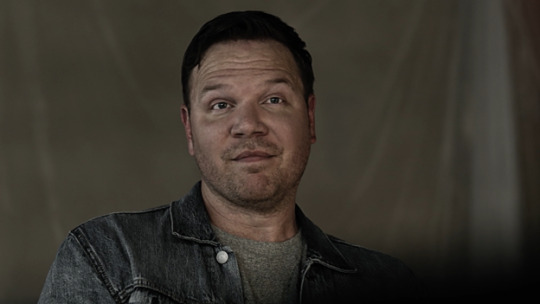
LIKE FATHER, LIKE SON
One of my favorite relationships on Lone Star is the relationship between Captain Owen Strand and his son, TK Strand. These two are very close and even work in the same firehouse. I love how TK's being gay is such a non-issue for both Owen and the show. TK is openly gay, he's in a serious relationship, and while Owen isn't exactly thrilled about him wanting to propose to his boyfriend, he supports his decision to do so.

When TK learns his boyfriend is in love with someone else, it crushes him. It is then we learn that TK is a recovering addict and the rejection is enough for him to break his sobriety. Owen ends up finding TK before it's too late but it's all the encouragement the older Strand needs to leave New York City and start anew with TK at his side.

TK isn't the only Strand dealing with something big. Right before their big move to Austin, Owen is diagnosed with lung cancer, a result of his being at the Twin Towers on September 11th. I think it's interesting that Owen demands that TK be transparent at all times about his sobriety, or lack thereof, but Owen decides to keep his diagnosis a secret.

126: NEXT CLASS
Part of the agreement of relocating to Austin to restart the 126 is that Owen will diversify the team. One of the major complaints I have seen regarding Lone Star is that it's *too woke* and it's *diversity for diversity's sake*. I like that the show is self-aware enough to have Owen point this out. Ultimately when assembling a team of first responders you want the best of the best and you wouldn't want to hire someone based on their race or sexuality or gender identity when there are more qualified candidates. What the show does right is it gives viewers a valid reason for the inclusion of the new firefighters. Marjan Marwani (Natacha Karam), a proud Muslim woman) is a bit of a wild card but she is good at the job and doesn't mind inserting herself in dangerous situations. So is Paul Strickland (Brian Michael Smith) who is easily one of the smartest on the team. He just so happens to be a trans man. The only head-scratcher is Mateo Chavez (Julian Works) who has failed the firefighter's exam multiple times but his work ethic is unparalleled and Owen clearly sees untapped potential in the young firefighter. I do find it interesting that viewers of the show have poked fun at the *wokeness* of the show but I rarely if ever hear similar critiques about the OG series whose 118 boasts a black lesbian, an Asian immigrant, and a Latino. If the argument is that they don't make a big deal out of the diversity of the 118 then that's not true. Hen's sexuality and race plays a big part in the show. As does Chimney's being Asian and Eddie's being half-Mexican. Anywho, whether you love or hate them, the new hires are a breath of fresh air and along with Owen, TK, and Judd they make an incredible team.

WE HAVE TO TALK ABOUT IRIS
So, I know I said I would be addressing the most notable parts of the episode and while Iris Blake (Liv Tyler) is not my favorite character on the show, I do think her inclusion on the show is important. Iris is the paramedic captain and her team consists of Tim Rosewater (Mark Elias) and Nancy Gillian (Briana Baker). As a fan of the OG series, the 118 is one big team. There's the firefighters and the paramedics. They ride in the same truck unless they need to have an ambulance at the scene. They're all super close. On Lone Star, Iris is the first to point out that the firefighters and paramedics are separate units. This easily added an interesting dynamic to the show. Instead of having one captain, there are two and I like that Owen wasn't an asshole about it.
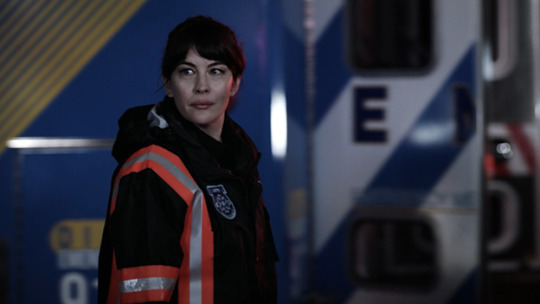
The reason Iris is such a meh character to me is there's zero joy about her. I get it though! Her sister is missing and she is justifiably upset and in agony over her disappearance. With that said, everytime Iris walks on screen it's like there's this dark cloud over her. She's the Eeyore of the 126 and it makes her unlikable. I do like that they fixed something that was an issue in the OG series' first season which is making sure all of our main characters are tethered to each other in some way. It appears her and Carlos Reyes (Rafael L. Silva) are friends so when he starts showing up places it doesn't seem random.
Overall, I like Liv Tyler. I think she is a competent actress. I just don't think she was a great addition to this show. As mentioned before, she is the reason I find it difficult to watch the first season which is a shame because season one is so good! One thing I will say about Iris that is positive is I like that she is a crusader for the less fortunate.
THE GENESIS OF TARLOS
Perhaps the most notable part of the episode is we get to see the beginnings of one of the most iconic duos in all of cable TV. If you go on any 9-1-1: Lone Star Reddit post or scroll through your Tumblr feed long enough, eventually you're going to encounter Tarlos. Tarlos is Lone Star's equivalent of Buddie; only these characters are actually gay and it totally makes sense for them to be romantically-involved. Sorry, Buddie shippers! Alas, I'm getting ahead of myself.
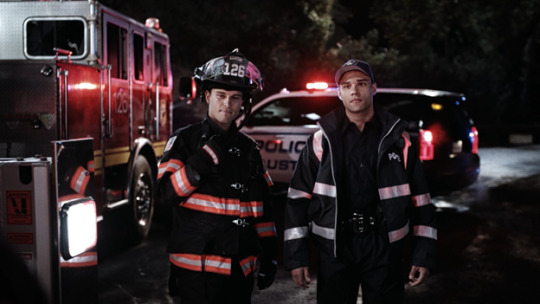
I totally forgot that Tarlos actually happens in the pilot episode. The first interaction we see of TK and Carlos is at the scene of an accident. Carlos makes a comment about Owen and TK tells him that's his dad. We then see them at the honkytonk at the end of the episode and Carlos asks TK to dance. The chemistry between these two are evident from the start and it blows my mind that they have pretty much been together since day one.

All in all, this was a great way to introduce these new characters. I immediately liked everyone and everyone has a clear motivation. One character I didn't really get to speak about because she didn't really factor into any of the major storylines is Grace Ryder. Grace Ryder, hands down, is one of my favorite characters on the show and I can't wait to talk about her more in future reactions. I love her and Judd together. I love how level-headed she is and at times she seems like she's the only one who can get through to him. Like Tarlos, these two have been together since the very beginning and it's going to be fun seeing how we get to where we are currently with them. The same goes with all of our other characters.

So, to all my passengers, I ask that you buckle up because it's sure to be a bumpy ride. The real question is, will season one hold up to the memory I have of watching it the first go round or will I walk away loving it even more? Only time will tell! Only next time ...
#911 lone star reaction#tv reaction#tv reaction 2023#911 lone star reaction 2023#911 lone star#fox 911 lone star#911 ls s1#911 ls 1x01#blw reactions#blw reactions 2023
2 notes
·
View notes
Note
In case you were feeling a bit down here are some frogs and toads worth looking at:
Black rain frog - very round :)
Vietnamese mossy frog - yes, there are frogs that look like moss
Indian bullfrog - the colours!!
Glass frog - its skin in see-through so you can its organs. There’s also a specific species of glass frog nicknamed the Kermit frog because it looks like Kermit
Iberian spadefoot toad - I just think they look funny
Paedophryne amauensis - tiny frog!! It’s considered to be the world’s smallest vertebrate
Hairy frog - nicknamed the wolverine frog because it’ll break its own toe bones when threatened, which poke through the skin and act like claws
Suriname toad - pancake! very flat! It’s method of reproduction is also very strange: the eggs are embedded into the mothers back until they’re fully developed
Turtle frog - looks funny
Morogoro tree toad - looks like a small frog but is actually a toad. They come in different colours!
Shovel headed tree frog - they have a long funny looking nose (like a shovel!)
South American common toad - looks like a leaf and comes in many colours!
Desert rain frog - they’re round and they make a funny squeaky sound!! Very cute!
Goliath frog - BIG BOI!
I forgot to respond earlier I'm sorry 😭 But thank you!! So many friendly fellas to look at.......
1 note
·
View note
Text
Global Flexographic Printing Technology Market Growth Analysis 2024-2033
Overview and Scope
Flexographic printing technology is a modern printing technique that uses flexible plates to transfer ink onto various substrates. It’s ideal for high-speed, large-volume printing on paper, plastics, and cardboard, commonly used in packaging and labeling. Flexographic printing technology is widely used across industries to produce labels, packaging materials, newspapers, and corrugated cardboard.

The flexographic printing technology market size is expected to see strong growth in the next few years. It will grow to $3.43 billion in 2028 at a compound annual growth rate (CAGR) of 7.7%. The growth in the forecast period can be attributed to digitalization and industry 4.0 integration, customization and personalization demands, sustainability initiatives, emerging markets. Major trends in the forecast period include hybrid printing solutions, increased automation and robotics, focus on operational efficiency, expansion of applications, development of sustainable inks and substrates, integration of iot and connectivity.
Segmentation & Regional Insights
The flexographic printing technology market covered in this report is segmented –
1) By Product Type: Inline Type Press, Stack Type Press, Central Impression Type Press
2) By Technology: Semi Automatic, Automatic
3) By Coloring Capacity: 2 Color, 4 Color, 6 Color And Above
4) By Application: Print Media, Office And Admin, Industrial Applications
North America was the largest region in the flexographic printing technology market in 2023. Asia Pacific is expected to be the fastest-growing region in the forecast period. The regions covered in the flexographic printing technology market report are Asia-Pacific, Western Europe, Eastern Europe, North America, South America, Middle East, Africa.
Major Driver Impacting Market Growth
The increasing packaging industry is expected to drive the growth of the flexographic printing technology market going forward. The packaging industry encompasses a wide range of products and services designed to protect, contain, and present goods for distribution, storage, sale, and use. The packaging industry is increasing due to the surge in online shopping, which has driven up the need for packaging materials to ensure the safe delivery of products. Flexographic printing machines allow for printing on various substrates such as paper, cellophane, metallic films, and plastics, making them ideal for printing food packaging and product labels. For instance, in March 2024, according to the American Forest & Paper Association (AF&PA), a US-based association for the advancement of paper and wood product producers, February 2024 witnessed a 5% increase in exports of packaging sheets and specialized packaging over February 2023. Therefore, the increasing packaging industry is expected to propel the growth of the flexographic printing technology market.
Key Industry Players
Major companies operating in the flexographic printing technology market are Fujifilm Holdings Corporation, DuPont de Nemours Inc., Heidelberger Druckmaschinen AG, Flint Group, Bobst Group SA, Koenig & Bauer Flexotecnica S.p.A., Eastman Kodak Company, Windmoeller & Hoelscher Corporation, Esko, BFM S.r.l., Mark Andy Inc., UTECO Converting S.p.A., Comexi Group, Nilpeter A/S, Rotatek S.A., Soma Engineering, Edale Limited, Polygraph Printing Technologies Ltd., Aim Machintechnik Pvt. Ltd., Ryobi Limited, Taiyo Kikai Ltd., Donghang Graphic Technology Inc., OMET S.r.l., Shanghai Printyoung International Industry Co., Wolverine Flexographic LLC, Allstein GmbH
The flexographic printing technology market report table of contents includes:
1. Executive Summary
2. Flexographic Printing Technology Market Characteristics
3. Flexographic Printing Technology Market Trends And Strategies
4. Flexographic Printing Technology Market — Macro Economic Scenario
5. Global Flexographic Printing Technology Market Size and Growth
.
.
.
31. Flexographic Printing Technology Market Other Major And Innovative Companies
32. Global Flexographic Printing Technology Market Competitive Benchmarking
33. Global Flexographic Printing Technology Market Competitive Dashboard
34. Key Mergers And Acquisitions In The Flexographic Printing Technology Market
35. Flexographic Printing Technology Market Future Outlook and Potential Analysis
Explore the trending research reports from TBRC:
Contact Us:
The Business Research Company
Europe: +44 207 1930 708
Asia: +91 88972 63534
Americas: +1 315 623 0293
0 notes
Text
Here are 20 of the biggest upsets in sports history, along with some details on why they were so surprising:
1. Miracle on Ice (1980): The U.S. men's hockey team, made up of amateur and collegiate players, defeated the heavily-favored Soviet team in the semi-finals of the Winter Olympics. The victory was seen as a symbol of American resilience and patriotism during the Cold War.
2. Leicester City's Premier League Championship (2016): Leicester City, a small soccer club with 5,000-to-1 odds of winning the Premier League, shocked the world by taking home the title. Their improbable run captivated fans around the globe.
3. Buster Douglas defeats Mike Tyson (1990): In one of the biggest upsets in boxing history, James "Buster" Douglas knocked out the previously undefeated Mike Tyson in the tenth round of their heavyweight title fight.
4. Appalachian State defeats Michigan (2007): Appalachian State, a small college football program, stunned the Michigan Wolverines in Michigan Stadium. The Mountaineers became the first Division I-AA team to beat a ranked Division I-A team.
5. Rulon Gardner wins gold (2000): Rulon Gardner, an American wrestler, defeated the heavily-favored Russian Alexander Karelin in the Greco-Roman heavyweight final at the Sydney Olympics. Karelin had not lost a match in 13 years and was considered unbeatable.
6. The Miracle Mets (1969): The New York Mets, a newly-formed expansion team, won the World Series in their first playoff appearance. They defeated the heavily-favored Baltimore Orioles in five games.
7. Joe Namath's Guarantee (1969): New York Jets quarterback Joe Namath guaranteed victory over the heavily-favored Baltimore Colts in Super Bowl III. The Jets won 16-7, and Namath's guarantee became legendary.
8. Japan defeats South Africa (2015): In one of the biggest upsets in rugby history, Japan defeated South Africa in the opening round of the 2015 Rugby World Cup. The Brave Blossoms had never won a World Cup match before.
9. The 1985 Villanova Wildcats: Villanova, an eighth-seeded college basketball team, defeated Georgetown in the NCAA championship game. The Wildcats shot an incredible 78.6% from the field in the game.
10. The 1980 Wimbledon Final: Bjorn Borg, who had won the previous four Wimbledon titles, was defeated by unheralded American John McEnroe in an epic five-set match.
11. The 2004 Boston Red Sox: The Red Sox became the first team in baseball history to come back from a 3-0 deficit in a playoff series. They went on to win the World Series, ending an 86-year championship drought.
12. The 1991 Minnesota Twins: The Twins, who finished last in their division the previous year, won the World Series. They defeated the heavily-favored Atlanta Braves in seven games.
13. The 1985 Chicago Bears: The Bears, led by their dominant defense, steamrolled their way to the Super Bowl. They defeated the New England Patriots 46-10, one of the most lopsided Super Bowl victories in history.
14. The 1999 U.S. Women's Soccer Team: The U.S. women's soccer team, led by Mia Hamm and Brandi Chastain, won the World Cup in dramatic fashion. Chastain's game-winning penalty kick and subsequent celebration became iconic moments in sports history.
15. The 1992 Duke Blue Devils: Duke, a team that many experts believed was too small and too young to compete at the highest level, won the NCAA basketball championship. They defeated the heavily-favored Michigan Wolverines in the final.
16. The 1992 U.S. Men's Basketball Team: The "Dream Team," made up of NBA superstars like Michael Jordan and Magic Johnson, dominated the Olympic basketball tournament. They won each game by an average of 44 points.
17. The 2006 Miami Heat: The Heat, led by an aging Shaquille O'Neal and a young Dwyane Wade, defeated the heavily-favored Dallas Mavericks in the NBA Finals. The Heat became the first team in NBA history to come back from a 2-0 deficit to win the championship.
18. The 1950 World Cup: The United States, a team made up mostly of amateurs and semi-professionals, defeated England 1-0 in one of the biggest upsets in soccer history. The game is known as the "Miracle on Grass."
19. The 2001 New England Patriots: The Patriots, led by quarterback Tom Brady, won the Super Bowl as heavy underdogs. They defeated the "Greatest Show on Turf" St. Louis Rams in one of the most thrilling Super Bowl games ever played.
20. The 2011 Dallas Mavericks: The Mavericks, a team that had been labeled as playoff chokers for years, won the NBA championship. They defeated the heavily-favored Miami Heat, led by LeBron James, in six games. Dirk Nowitzki was named Finals MVP.

1 note
·
View note
Text
College Football By State - Pennsylvania
FBS:
Penn State Nittany Lions - University Park, Pennsylvania - They first played in 1881. They are in the Big Ten.
Pittsburgh Panthers - Pittsburgh, Pennsylvania - They first played in 1890. They are in the ACC.
Temple Owls - Philadelphia, Pennsylvania - They first played in 1894. They are in the American Athletic Conference (AAC).
FCS:
Bucknell Bison - Lewisburg, Pennsylvania - Their program was established in 1883. They are in the Patriot League.
Duquesne Dukes - Pittsburgh, Pennsylvania - Their program was established in 1891. They are in the Northeast Conference (NEC).
Lafayette Leopards - Easton, Pennsylvania - Their program was established in 1882. They are in the Patriot League.
Lehigh Mountain Hawks - Bethlehem, Pennsylvania - Their program was established in 1884. They are in the Patriot League.
University Of Pennsylvania Quakers - Philadelphia, Pennsylvania - Their program was established in 1876. They are in the Ivy League.
Robert Morris Colonials - Moon Township, Pennsylvania - Their program was established in 1994. They are in the Big South Conference.
Saint Francis (PA.) Red Flash - Loretto, Pennsylvania - Their program was established in 1909. They are in the NEC.
Villanova Wildcats - Villanova, Pennsylvania - Their program was established in 1894. They are in the Colonial Athletic Conference (CAA).
D2:
Bloomsburg University Huskies - Bloomsburg, Pennsylvania - They are in the Pennsylvania State Athletic Conference (PSAC).
California (PA.) Vulcans - California, Pennsylvania - They are in the PSAC.
Clarion Golden Eagles - Clarion, Pennsylvania - They are in the PSAC.
East Stroudsburg University Warriors - East Stroudsburg, Pennsylvania - They are in the PSAC.
Edinboro Fighting Scots - Edinboro, Pennsylvania - They are in the PSAC.
Gannon University Golden Knights - Erie, Pennsylvania - They are in the PSAC.
Indiana University (PA.) Crimson Hawks - Indiana, Pennsylvania - They are in the PSAC.
Kutztown University Golden Bears - Kutztown, Pennsylvania - They are in the PSAC.
Lincoln University (PA.) Lions - Lower Oxford, Pennsylvania - They are in the Central Intercollegiate Athletic Association (CIAA).
Lock Haven University Bald Eagles - Lock Haven, Pennsylvania - They are in the PSAC.
Mercyhurst University Lakers - Erie, Pennsylvania - They are in the PSAC.
Millersville University Marauders - Millersville, Pennsylvania - They are in the PSAC.
Seton Hill University Griffins - Greensburg, Pennsylvania - They are in the PSAC.
Shippensburg University Red Raiders - Shippensburg, Pennsylvania - They are in the PSAC.
Slippery Rock University The Rock - Slippery Rock, Pennsylvania - They are in the PSAC.
West Chester University Golden Rams - West Chester, Pennsylvania - They are in the PSAC.
D3:
Albright Lions - Reading, Pennsylvania - They first played in 1912. They are in the Middle Atlantic Conferences (MAC).
Allegheny Gators - Meadville, Pennsylvania - They first played in 1893. They are in the Presidents' Athletic Conference (PAC).
Alvernia Golden Wolves - Reading, Pennsylvania - They first played in 2018. They are in the MAC.
Carnegie Mellon Tartans - Pittsburgh, Pennsylvania - They first played in 1906. They are in the PAC.
Delaware Valley Aggies - Doylestown, Pennsylvania - They first played in 1948. They are in the MAC.
Dickinson Red Devils - Carlisle, Pennsylvania - They first played in 1896. They are in the Centennial Conference.
Eastern Eagles - St. David's, Pennsylvania - They first played in 2022. They are in the MAC.
Franklin & Marshall Diplomats - Lancaster, Pennsylvania - They first played in 1887. They are in the Centennial Conference.
Geneva Golden Tornadoes - Beaver Falls, Pennsylvania - They first played in 1890. They are in the PAC.
Gettysburg Bullets - Gettysburg, Pennsylvania - They first played in 1890. They are in the Centennial Conference.
Grove City Wolverines - Grove City, Pennsylvania - They first played in 1892. They are in the PAC.
Juniata Eagles - Huntingdon, Pennsylvania - They first played in 1920. They are in the Landmark Conference.
Keystone Giants - La Plume, Pennsylvania - They first played in 1936. They are in the Landmark Conference.
King's Monarchs - Wilkes-Barre, Pennsylvania - They first played in 1946. They are in the MAC.
Lebanon Valley Flying Dutchmen - Annville, Pennsylvania - They first played in 1897. They are in the MAC.
Lycoming Warriors - Williamsport, Pennsylvania - They first played in 1954. They are in the Landmark Conference.
Misericordia Cougars - Dallas, Pennsylvania - They first played in 2012. They are in the MAC.
Moravian Greyhounds - Bethlehem, Pennsylvania - They first played in 1931. They are in the Landmark Conference.
Muhlenberg Mules - Allentown, Pennsylvania - They first played in 1900. They are in the Centennial Conference.
St. Vincent Bearcats - Latrobe, Pennsylvania - They first played in 1923. They are in the PAC.
Susquehanna River Hawks - Selinsgrove, Pennsylvania - They are in the Landmark Conference.
Thiel Tomcats - Greenville, Pennsylvania - They are in the PAC.
Ursinus Bears - Collegeville, Pennsylvania - They are in the Centennial Conference.
Washington & Jefferson Presidents - Washington, Pennsylvania - They first played in 1890. They are in the PAC.
Waynesburg Yellow Jackets - Waynesburg, Pennsylvania - They first played in 1895. They are in the PAC.
Westminster (PA.) Titans - New Wilmington, Pennsylvania - They first played in 1891. They are in the PAC.
Widener Pride - Chester, Pennsylvania - They first played in 1879. They are in the MAC.
Wilkes Colonels - Wilkes-Barre, Pennsylvania - They first played in 1946. They are in the Landmark Conference.
The Awards:
My Favorite Mascot (FBS-D2 Level) - The Rock of Slippery Rock.
Honorable mentions - St. Francis Red Flash, California (PA.) Vulcans, Millersville University Marauders, and the Seton Hill Griffins.
My Favorite Mascot (D3 Level) - Geneva Golden Tornadoes.
Honorable mentions - Alvernia Golden Wolves. Franklin & Marshall Diplomats, Gettysburg Bullets, King's Monarchs, and the Lebanon Valley Flying Dutchmen.
The "Uhh Umm" Award - Dickinson Red Devils (in Carlisle, Pennsylvania).
The "Totally Metal!" Award - Gettysburg Bullets.
The "Star Trek" Award - California (PA.) Vulcans.
The "Thanks, I Just Had It Stuffed" Award - The Geneva Golden Tornadoes of Beaver Falls, Pennsylvania.
The "Cool Town Name" Award - Moon Township, Pennsylvania (Home of the Robert Morris Colonials).
0 notes
Text
Multituberculate Earth: Microcosmodontidae

Microcosmodontids are a fairly mysterious multituberculate clade, not known from anything more complete than lower jaws. As such, their portrayal in this project is indeed pretty speculative. However, a few things can be certain: they had positively massive lower incisors (example toothers here) characterised by a thin enamel band, and they rank among the carnivorous/omnivorous taxa in dietary studies. Thus, they seem to have been mostly smol shrew analogues.
In our timeline, they disappear after the Danian. In this one, suffice to say, they continue to occupy small insectivorous niches across the northern hemisphere; one species, Tumi yumi, occurs in the Santa Lucía Formation, implying a brief forray into South America. However, already by the Paleocene do these animals try to climb in the trophic web, there being a variety of small carnivores akin to weasels and stoats. The latest Paleocene of Asia has already species as large as a wolverine, the forerunners to a new world order.
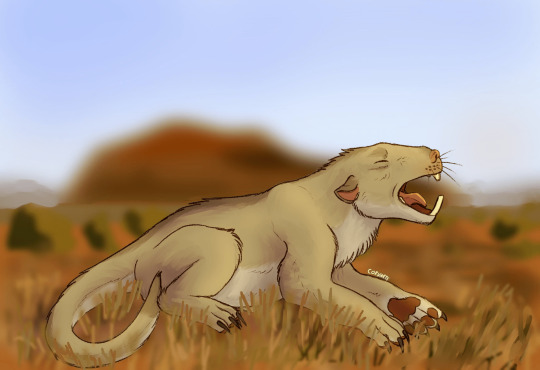
The Grand Coupure proved to be another great opportunity for these ambitious cretins. Once again, their more generalistic habits allowed them to prevail where the either too arboreal or too hypercarnivorous ptilodontoideans failed, and while European forms became extinct alongside pretty much all other local flightless mammals the Asian and North American forms established themselves truly at all levels of government from small digging insectivores to marten-like arborealists to cursorial dog-like runners to some of the largest land mammal carnivores of all time at over a ton.
The key for microcosmodontid success is the perfect blend of predatory traits with an omnivorous way out, not unlike our own carnivorans. The plagiaulacoid is fairly well developed for sheathering meat (though proportionally smaller than that of ptilodontodieans and eucosmodontids) while molars remain broad enough to process soft plant matter, while a spectacular killing tool remains at all times: massive lower incisors, sometimes longer than the jaw itself. The latter effectively operate like the long fangs of saber-toothed cats and similar predators in our timeline, used to stab prey critically. However, they are more robust and thus durable, thus they are more versatile.
Small prey are easily skewered, while larger ones are wrestled until the teeth stab through the throat or disembowel the torso. Much like in Thylacosmilus and some carnivoran saberteeth the fangs are strong enough to be used in opening the carcass. And there’s also the less romantic option of using these incisors as shoveling tusks, digging up tubers. A few species also use these teeth to break open termite nests, though curiously few have specialised as mymercophages compared to other mammal groups at this point.
Combining everything you love about mustelids, bears and saber toothed tigers, microcosmodontids only have to contend with eucosmodontids as far as competition goes, with some kogaionids and ptilodontoideans occuring at the edges of their range like in South and Southeast Asia (or flying overhead). As the Oligocene progresses, the seaways between Afro-Arabia and Asia and between North and South America grow narrower; will these be playing grounds, or will they have a challenge at last?
#multituberculate earth#multituberculate#multituberculata#speculative zoology#speculative biology#spec evo#speculative evolution
1 note
·
View note